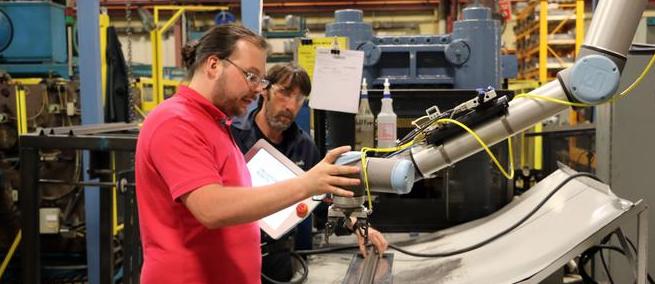Mitigate Skilled Labor Shortage with Automation and Cross Training

It’s no secret there’s a labor shortage facing many industries. In the manufacturing sector, more than 500,000 jobs currently remain vacant in the United States. According to a recent study by Deloitte and The Manufacturing Institute, the manufacturing skills gap in the U.S. could result in 2.1 million unfilled jobs by 2030.
To make matters worse, a Society of Human Resource Management report indicates nearly 27% of manufacturing workers will retire over the next ten years, along with their specialized skills and institutional knowledge.
What is a manufacturing business owner to do?
Technology and Automation
 Utilizing technology and automation can be key solutions. Automating some of the most repetitive steps or tasks in your operations or production process fosters the reallocation of some of your workforce to other areas of your business where their skillset could be applicable.
Utilizing technology and automation can be key solutions. Automating some of the most repetitive steps or tasks in your operations or production process fosters the reallocation of some of your workforce to other areas of your business where their skillset could be applicable.
Robotics and automation can also go a long way in landing younger talent who may not have been looking for a job in manufacturing but the technology in the work environment makes it more attractive to them. It also shows you are investing in the business and are committed to making the necessary moves to compete with companies around the world.
In addition, business owners who are nearing retirement or simply looking to exit their companies in the next few years will discover that many prospective buyers seriously consider the investments you have or have not made in technology and automation.
So much is available in the world of robotics, sensors and automation. It is becoming more affordable and there are increasingly more integrators with expertise to help you determine where you have opportunities within your process and what the timeframe is for payback on the investments.
Technology facilitates innovation which drives business growth and it can be a driving force leading to better efficiency and a more competitive advantage. And it just might be cool enough for those young people who don’t consider industrial manufacturing as a desirable career path to reconsider their thinking.
Cross-Trained Workforce
 Another solution for manufacturing business owners looking to address the skilled labor shortage is a flexible, cross-trained workforce.
Another solution for manufacturing business owners looking to address the skilled labor shortage is a flexible, cross-trained workforce.
Cross-training employees has many benefits, both to the company and the workers themselves. It is an excellent way to expand the skillset and capabilities of your employees and to give them a broader view of different parts of the business. Your company becomes more productive and enables you to staff more strategically.
The timing to consider cross-training is ideal given the ever-increasing number of older workers departing the workforce. It gives a business owner the opportunity to pair up the next generation employees with some of those baby boomers who will be retiring in the next few years.
Cross-training helps employees become more capable of dealing with the daily ups and downs in demand. They are also better able to react to and handle incremental workloads on days when other team members are out sick, on vacation or dealing with an emergency.
If your business relies on temps or faces seasonal peaks and valleys that have you hiring and then letting people go when it slows down, cross-training may mitigate the need for such a move each year.
A cross-training approach can be extremely powerful when paired up with a team-based culture and process improvement initiatives. It often eliminates the need to add staff to production and provides a real sense of pride in the team’s ability to improve metrics in your organization. It’s a win-win situation that can improve your business and better engage your employees.
For more information about cross-training or automation at your business, contact CONNSTEP to schedule a no-cost, no-obligation discovery meeting.
Related Items
Often basic housekeeping is overlooked in favor of “productivity.” This is a common practice but one that costs you over the long run. Putting a basic 5S program in place is inexpensive and yields a great return on your (small) investment.
[Case Study] Enterprise-Wide Lean Transformation Drives Growth & Revenue
The company tasked itself to grow the business with current resources by becoming more efficient, reducing waste, and developing more productive internal capabilities.
Continuous Improvement Champion Certification (CICC)
This course provides comprehensive exposure to the principles and practices needed to develop and sustain a Lean Enterprise. You will receive immediate reinforcement of the classroom learning by applying your training to a real-life project within your organization.
